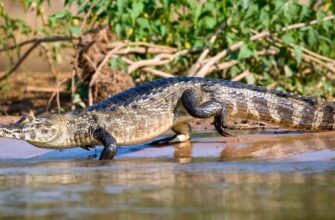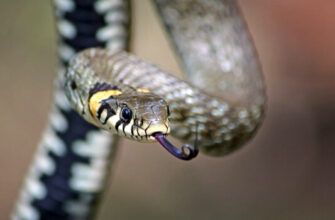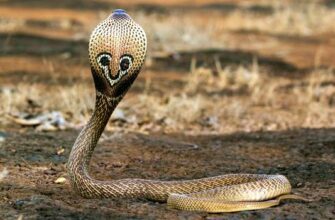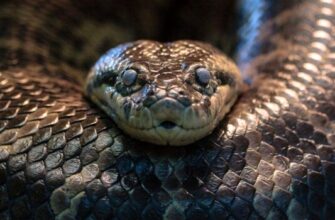The alligator is a reptile from the order of crocodiles, but with a number of differences from its other representatives. They live in lakes, swamps and rivers. These awe-inspiring reptiles reminiscent of dinosaurs are indeed predators, capable of rapid movement both in water and on land, have very powerful jaws and a tail.
View origin and description
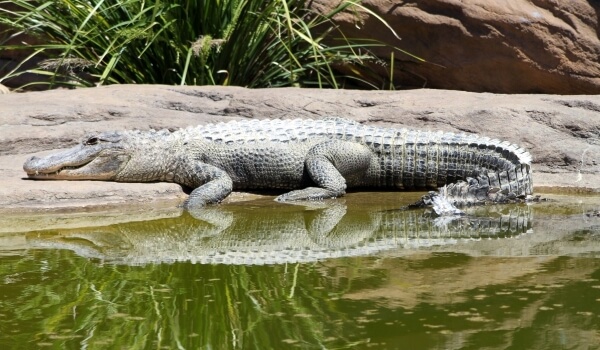
Photo: Alligator
Alligators should not be confused with other crocodiles – they separated a very long time ago, back in the Cretaceous period. Some impressive lizards of antiquity belonged specifically to the alligator family – for example, Deinosuchus. It reached 12 meters and weighed about 9 tons. In its structure and way of life, Deinosuchus resembled modern alligators and was a top predator that fed on dinosaurs. The only known representative of crocodilians with horns, ceratosuchus, also belonged to alligators.
The ancient representatives of the alligators dominated the planet’s fauna for a long time, but after the change in natural conditions, due to which the dinosaurs died out, most of them also disappeared, including the largest species. For a long time it was believed that the current crocodile, including alligators, are living fossils that have remained almost unchanged for many millions of years, but modern research has established that modern species formed after the extinction of most of the ancient representatives of the alligator family.
Until now, only two subfamilies have survived – caimans and alligators. Among the latter, two types are also distinguished: Mississippian and Chinese. The first scientific description of the Mississippi alligator was made in 1802, the species living in China was described later – in 1879.
Appearance and features
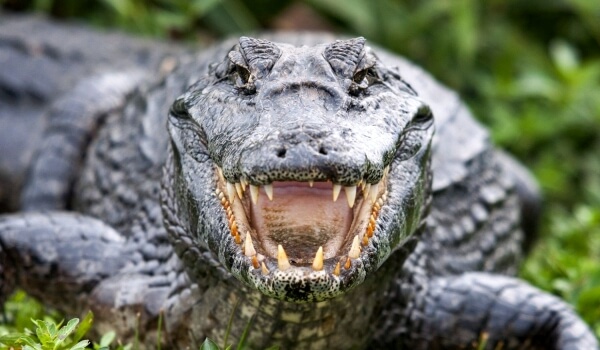
Photo: Animal Alligator
American alligators are larger than Chinese relatives – their length can be up to 4 meters, and in rare cases even more. They can weigh up to 300 kilograms, but usually 2-3 times less. The largest specimen weighed a ton and had a length of 5.8 meters – although scientists doubt the reliability of this information, and the complete skeleton of the giant has not been preserved.
Adult Chinese alligators reach 1.5-2 meters, and their weight rarely exceeds 30 kilograms. There are also references to larger individuals – up to 3 meters, but their complete skeletons have also not been preserved.
The color may vary depending on the place where the alligator lives. If there is a lot of algae in the reservoir, it will acquire a green tint. In heavily waterlogged, containing a lot of tannic acid – light brown. Reptiles living in dark and muddy waters become darker, their skin takes on a dark brown, almost black color.
Conformity to the surrounding area is important for successful hunting – otherwise reptiles will be much more difficult to camouflage and stay unnoticed. Regardless of the main color, they always have a light belly.
If in American alligators the bone plate covers only the back, then in Chinese it protects the whole. On the front paws, both have five fingers, but on the hind legs only four. Long tail – it is approximately equal to the rest of the body. With its help, alligators swim, use it in fights, build a nest, because it is powerful. It also accumulates reserves for wintering.
The bony scutes that protect the eyes give a metallic sheen to the eyes, while at night the eyes of young alligators acquire a green glow, and adults – red. There are usually about 80 teeth in a Mississippian, and a little less in a Chinese. When broken off, new ones can grow.
An interesting fact: the bite of the Mississippi alligator is the most powerful among all predators. Strength is needed to crack through tough turtle shells.
When a reptile dives under water, its nostrils and ears cover the edges of the skin. In order to have enough oxygen for a long time, even the blood circulation in his body becomes much slower. As a result, if an alligator consumes the first half of the air supply in half an hour, then the second can last for several hours.
It is possible to distinguish an alligator from ordinary crocodiles by a number of features:
- wider snout, has the shape of the letter U, in real crocodiles its shape is closer to V;
- with a closed jaw, the lower tooth is clearly visible;
- eyes are located higher;
- lives only in fresh water (although it can also swim in salt water).
Where does the alligator live?
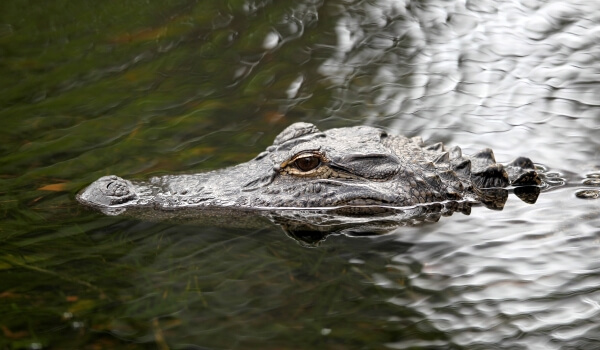
Photo: Alligator in water
Mississippi alligators can be found along almost the entire length of the US Atlantic coast, except for its northernmost part. But most of them are in Louisiana and especially in Florida – it is in this state that up to 80% of the entire population lives.
They prefer lakes, ponds or swamps, they can also live in slowly flowing lowland rivers. Life requires fresh water, although sometimes they are chosen in salty areas.
If tamed animals come to the watering hole to the habitat of the Mississippi alligator, then it is easier to catch them, because they are less shy. Because alligators can settle near people and eat domestic animals – they eat sheep, calves, dogs. During a period of drought, they can move to the suburbs in search of water and shade or even wander into pools.
The range of Chinese alligators, as well as their total number, has been greatly reduced due to human activities – now these reptiles live only in the Yangtze River basin, although previously they could be found in a wide area, including most of China and even the Korean Peninsula.
Chinese alligators also prefer slow flowing water. They try to hide from people, but can live nearby – in reservoirs used for agriculture, digging inconspicuous holes.
What does an alligator eat?
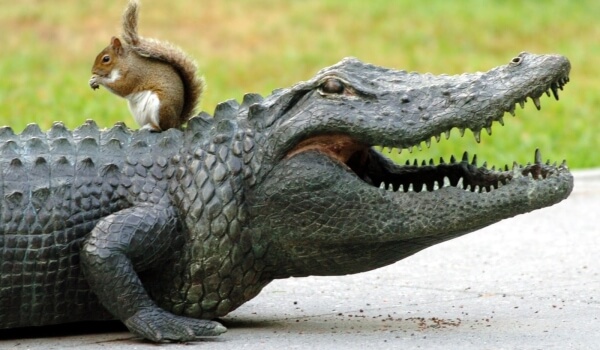
Photo: Alligator in America
Alligators are formidable predators that can feed on anything they can catch. They pose a threat to most of the inhabitants of the reservoir and its coast, because they have both the strength to cope with almost any of them, and sufficient dexterity to catch.
Their diet includes:
- fish;
- turtles;
- birds;
- small mammals;
- molluscs;
- insects ;
- cattle;
- fruits and leaves;
- other animals.
Depending on the reservoir and the abundance of fish in it, its percentage in the diet of alligators may vary, but it always forms its basis. According to the results of research by American scientists, this is approximately 50-80% of the food absorbed by the reptile.
But the alligator is not averse to diversifying the menu: for this, it hunts birds and rodents, and sometimes large animals. It also feeds on plants. Do not disdain adults and eating other people’s cubs. Hungry reptiles also eat carrion, but prefer to eat fresh meat.
The behavior of the alligator is highly dependent on the temperature of the water: the reptile is active in warm, about 25 ° C and more. If the water is cool, then it begins to behave more sluggishly, and its appetite is greatly reduced.
It prefers to hunt at night and uses different methods depending on the size of the prey. Sometimes it can wait for the victim for hours, or watch it until the right moment comes for the attack. At the same time, the reptile usually remains under water, and only nostrils and eyes are visible above the surface – it is not easy to notice the hidden alligator.
Prefers to kill prey from the first bite and immediately swallow it completely. But if it is large, you have to resort to stunning with a tail blow – after that, the alligator drags the victim to a depth so that it suffocates. They do not like to hunt large animals, because their jaws are not the best suited for this – but sometimes they have to.
People are not afraid. They themselves can pose a danger to them, but they do not specifically attack – usually they only react to provocations. Usually, if you do not make sudden movements near the alligator, he will not show aggression. But there is a risk that the reptile will confuse the child with small prey.
Another exception would be alligators fed by humans, which is quite common. If the appearance of a person in a reptile begins to be associated with feeding, then it can attack when hungry. Chinese alligators are less aggressive than Mississippian alligators, their attacks on people are extremely rare, they are shy.
Interesting fact: Alligators’ patience does not extend to already caught prey. If she fights back for a long time, then the hunter may well lose interest in her and go in search of another.
Peculiarities of character and lifestyle
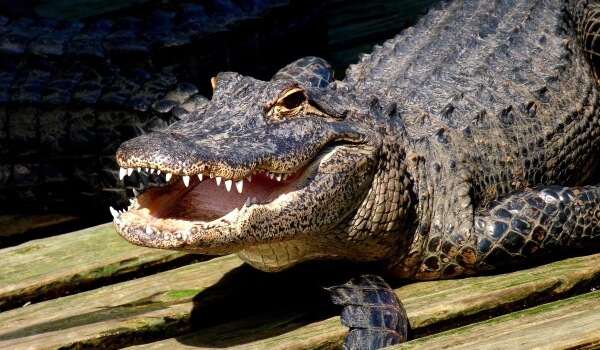
Photo: Alligator
Swim well and fast using their tail for rowing. They can also move quickly on land – they develop a speed of 20 km/h, but they are able to keep this pace only for a short distance. You can often see them resting on land, and they usually open their mouths so that the water evaporates faster.
At first, young alligators remain in the same place where they were born, but when they grow up, they begin to look for a new habitat. If young animals live in groups, then adults settle singly: females occupy smaller areas, males tend to occupy a large one.
They love slowly flowing water, sometimes they can create ponds, wielding their tail. Then they overgrow and are populated by small animals. It lives only in fresh water, although sometimes they can swim in salty water and stay there for a long time – but they are not adapted for permanent living in it.
The tail is also used for digging holes – complex and winding, stretching for tens of meters. Although most of such a hole is located above the water, the entrance to it must be underwater. If it dries up, the alligator has to dig a new hole. They are needed as a refuge in the cold season – several individuals can winter together in them at once.
Although not all alligators go into holes – some hibernate right in the water, leaving only their nostrils on it. The body of the reptile freezes into ice, and it stops responding to any external stimuli, all processes in its body slow down very much – this allows you to survive the cold. Long hibernation is typical for Chinese alligators, Mississippi can fall into it for 2-3 weeks.
If alligators managed to survive the most dangerous time of growing up, then it can reach 30-40 years. If conditions are favorable, they sometimes live even longer, up to 70 years – this is difficult to meet in the wild, because old individuals lose speed and cannot hunt as before, and their body requires no less than before due to its large size. .
Social structure and reproduction
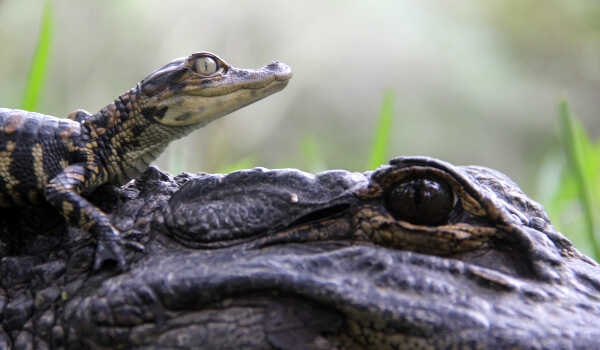
Photo: Baby Alligator
Sociality is inherent in alligators to a greater extent than other large crocodiles: only the largest individuals live separately, the rest huddle in groups. They communicate with each other with the help of screams – threats, warnings of imminent danger, mating calls and some other characteristic sounds stand out.
Chinese alligators reach puberty by about 5 years, American later – by 8. It is determined, however, not by age, but by the size of the reptile: Chinese need to reach a meter, Mississippi – two (in both cases, a little less for females and more for males ).
The mating season begins in the spring, when the water becomes warm enough for this. Therefore, in the cold years of the northernmost habitats, it may not occur at all. It is easy to understand when this season comes for alligators – males become more restless, often roar and swim around the boundaries of their zone, and may attack neighbors.
After mating, the female builds a nest on the shore of a reservoir, about a meter high. It is necessary to raise the masonry above the water level and prevent it from dying due to flooding. The female usually lays about 30-50 eggs, after which she covers the clutch with grass.
During the entire period of incubation, she protects the nest from other animals that can encroach on the eggs. It also monitors the temperature regime: in hot weather, it removes the grass, allowing the eggs to ventilate, if it’s cool, it scoops up more so that they stay warm.
Fun Fact: Few alligators live past two years of age – about one in five. Even fewer reach the age of puberty – about 5%.
By the end of the summer, young alligators hatch. At first, they are no more than 20 centimeters in length and very weak, therefore the protection of the female is very important for them – without it they will not be able to get out even from the hardened masonry. Once in the water, they form groups. If several clutches were placed side by side, the cubs of them are mixed, and mothers look after all without distinction. This concern may continue for several years.
Natural enemies of alligators
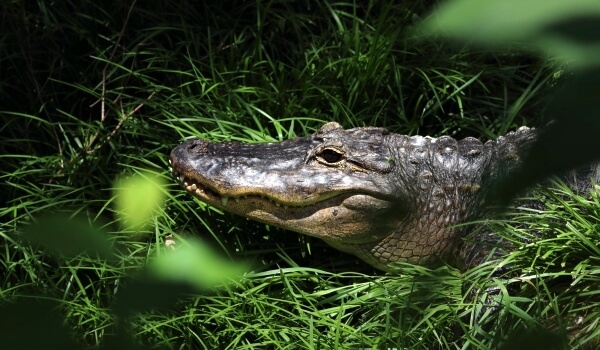
Photo: Alligator Red Book
In nature, like other representatives of crocodilians, they are at the very top of the food chain. But this does not mean that they can not be afraid of other animals: panthers and bears can pose a serious threat to them. However, the opposite is also true – alligators can also deal with them and eat them. But such situations are quite rare.
Other alligators are a greater threat – cannibalism is common among them, adults and strong individuals do not disdain to hunt smaller and weaker compatriots. This phenomenon becomes especially frequent if the population in the nearby area has become too high – then there may not be enough easy prey for everyone.
The most alligators, in addition to relatives, can be threatened by otters, raccoons, snakes and birds of prey. Also, they are sometimes attacked by large fish. For older, but still young individuals, lynxes and cougars are a serious threat – these felines usually do not attack on purpose, but cases of conflicts between them and alligators have been recorded.
After the Mississippian alligator grows up to 1.5 meters, he does not have any enemies in nature. The same is true for Chinese, although they are smaller. The only and most dangerous enemy for them is a man – after all, since ancient times people hunted crocodiles, including alligators, and exterminated them.
Population and species status
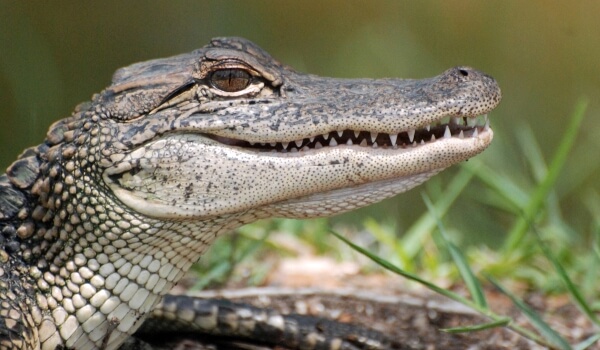
Photo: Animal Alligator
There are quite a few Mississippi alligators – there are over a million of them, so they are not threatened with extinction. Although not so long ago the situation was different: by the middle of the last century, the range and population were greatly reduced due to active poaching, as a result of which the authorities had to take measures to protect the species.
This had an effect, and its numbers recovered. Now in the United States, many crocodile farms have been opened, where they are successfully bred. In this way, it is possible to obtain valuable skin, as well as meat that is used for steaks, without damaging the number of wild reptiles.
Chinese alligators are another matter. There are only about two hundred of them in natural conditions, which is why the species was included in the Red Book. The population has declined largely due to poaching, since crocodile meat is considered medicinal, and other parts of it are also valued.
Fun fact: The Chinese name for local alligators translates to “dragon”. They probably served as a prototype for the mythological Chinese dragons.
But the main threat is not in this, but in the constant reduction of the territory habitable for alligators due to its development by man. Many of the ponds they used to live in are now used to grow rice. The locals sometimes clash with the reptiles, many are hostile towards them and do not believe that conservation of the species will be beneficial.
Alligator Conservation
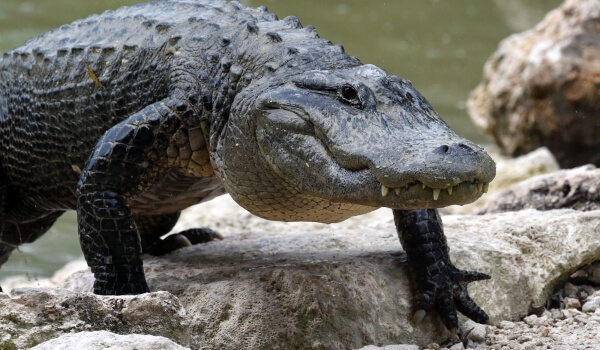
Photo: Large alligator
Even if the Chinese alligators disappear in nature, they will still be preserved as a species: thanks to successful breeding in captivity, there are about 10,000 of them in zoos, nurseries, private collections. This allows them to be successfully bred and expect to later introduce the species into the natural habitat or another locality.
But still, it is important that they are preserved in the wild, and measures are being taken for this: the Chinese authorities have created several nature reserves, but so far it has not been possible to completely stop the extermination of alligators even in them. Work is underway with local residents, strict bans are introduced and control over their implementation is being strengthened. This allows us to hope that the decline in the Yangtze River basin will be halted.
In addition, in recent years, an experiment has been conducted to introduce Chinese alligators in Louisiana, and so far it has been successful – it may be possible to achieve more rapid reproduction in more favorable natural conditions. If the experiment is considered successful, it may be repeated in other parts of the United States. Here they will coexist with their Mississippian relatives: but no additional measures are being taken to protect them – fortunately, there is no threat to the species.
Powerful alligators, although they should be admired from a distance, are beautiful and strong predators, remained almost unchanged for many millions of years. These reptiles are one of the important components of the fauna of our planet, and they certainly do not deserve the barbaric extermination that Chinese alligators are subjected to.

